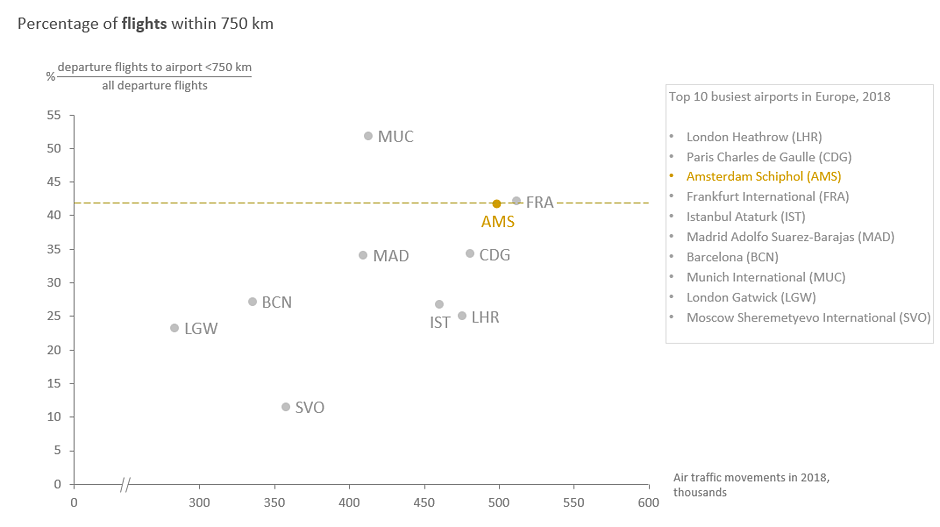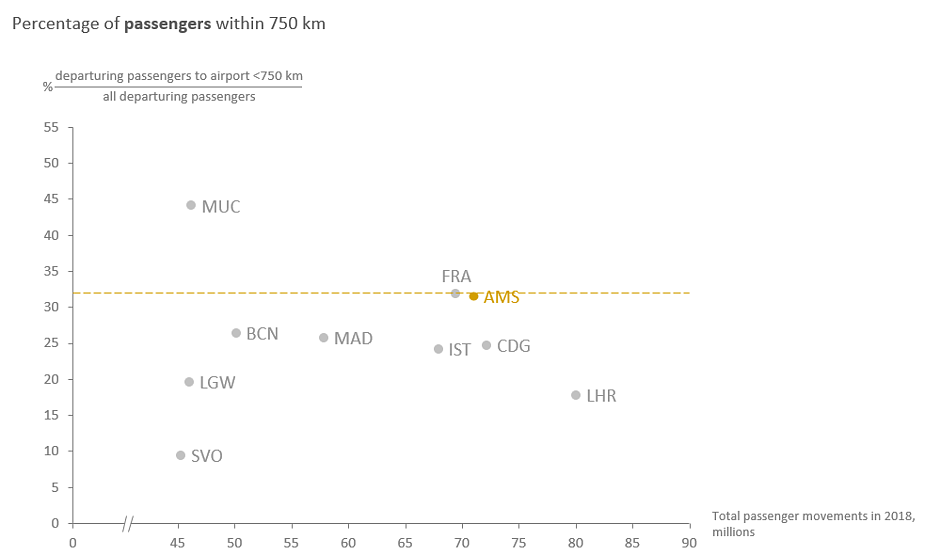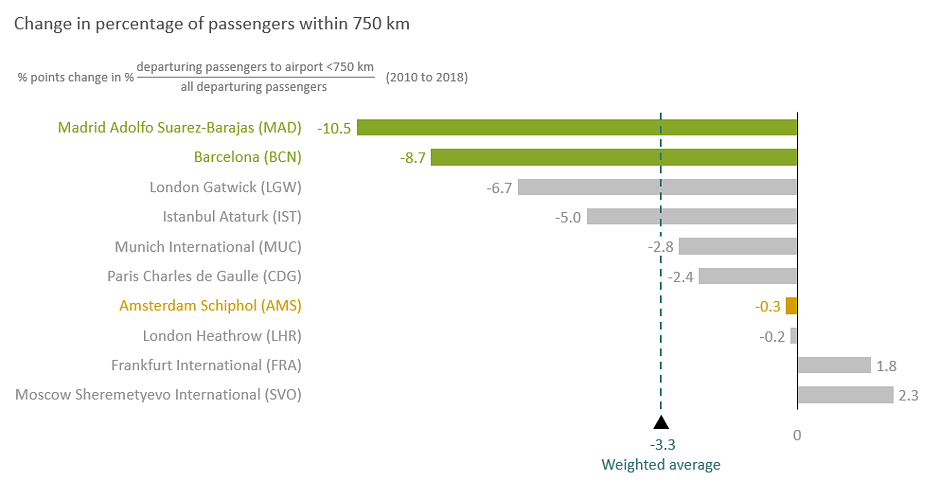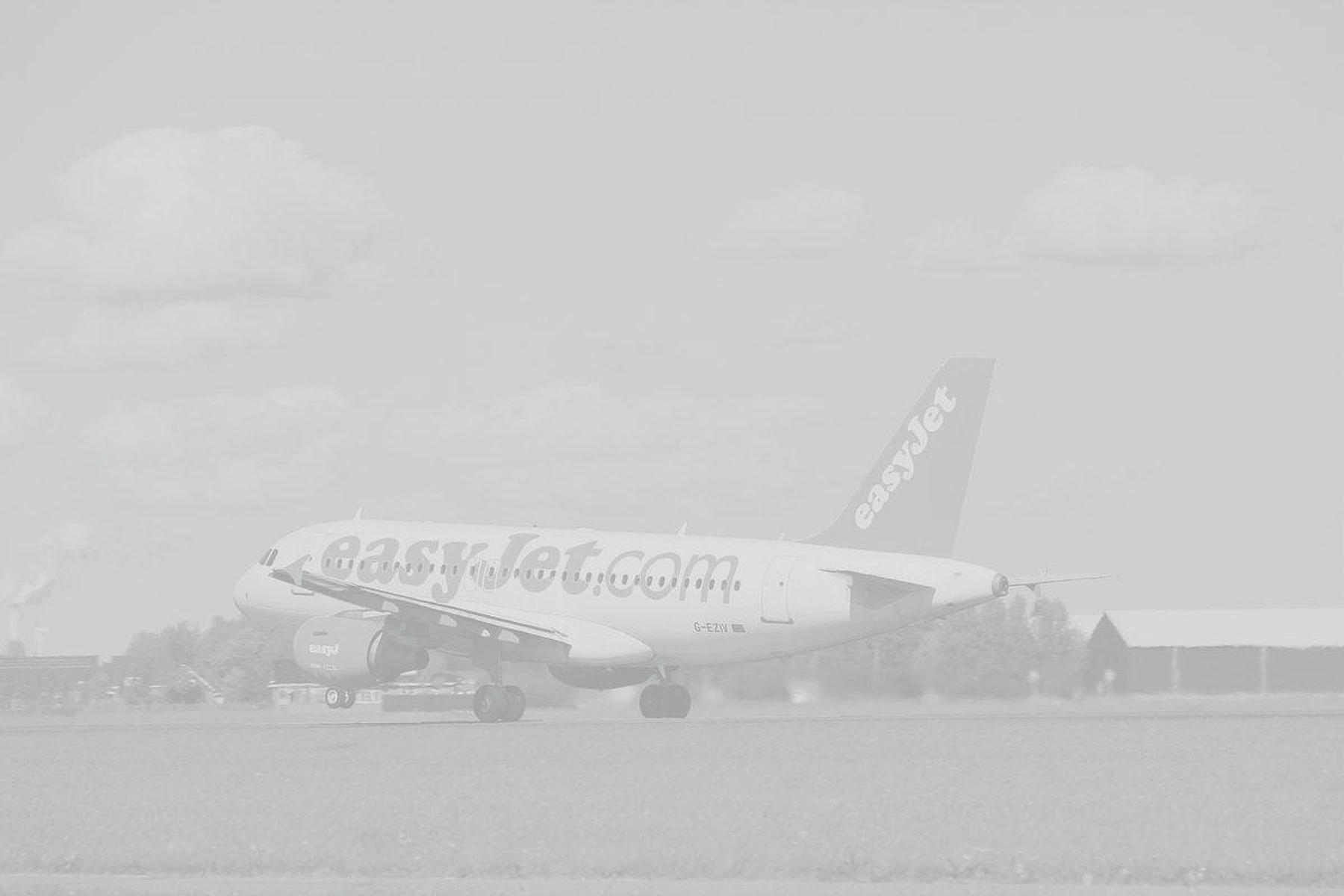Last month, Greenpeace hit the news. The report: 40% of all flights departing from Schiphol Airport are headed to an arrival airport within a radius of 750 kilometers.
The statistic shocked the environmental organization, which believes CO2 emissions from short-distance flights are an unnecessary burden on the environment, as many could be replaced by lower-emission train travel.
Is the Amsterdam-based hub an exception in facilitating so many short flights? Or do we observe similar ratios at other large European airports? And what could be the root causes of any differences in short-flight ratios? In this blog, we’ll dive into the data and put the numbers into perspective.
Schiphol Airport’s percentage: relatively high, yet no exception
Our calculation shows that Schiphol Airport’s short-flight ratio is 41.7% (1) – a bit higher than Greenpeace’s number. Now, if we compare the 10 busiest airports in Europe (2), we observe that Schiphol Airport’s 41.7% is relatively high. Its short-flight ratio is higher than Heathrow’s and Charles de Gaulle’s, but lower than Munich’s.

Environmental impact: size matters
Although 41.7% might sound like a significant number, it does not necessarily correspond with the percentage of environmental impact, which is likely smaller. Small aircraft emit less CO2 than their larger, heavier counterparts (the environmental impact of a flight with a modest Fokker 70 differs from that of an Airbus A380). In other words, size matters – especially since long-haul flights tend to be carried out by larger aircraft. To represent the impact of short-distance air travel in a more accurate – yet still imperfect – way, we should look at the percentage of passengers flying within the 750-kilometer range.

If we consider aircraft capacity and a higher load factor for long-haul flights (*3) – long flights are generally fuller – here’s what we find: for Schiphol Airport, 41.7% of departing flights under 750 kilometers translates into 31.5% of passengers departing to destinations within this range. This is still a very significant portion, and it’s relatively high compared to other airports.
So, what are the main causes of these differences?
Key underlying factors: geography and destination
Let’s consider geography for a moment. Out of Europe’s ten largest airports, the four with the lowest ratios of passengers traveling short distance – Moscow Sheremetyevo, Heathrow, Gatwick, and Istanbul Ataturk – are in the periphery of Europe. Both Heathrow and Gatwick are positioned on the very western edge, limiting the demand for westbound short-distance flights. Istanbul’s and Moscow’s peripheral locations, with a restricted number of large cities within the 750-kilometer range, seem to limit demand for short-distance flights as well.
Based on this logic, an airport’s geographic centrality is likely a key underlying factor for its ratio of short-distance flights.
The second factor we believe plays a major role is an airport’s focus on either European or intercontinental destinations. It might explain why almost half of Munich’s passengers travel under 750 kilometers. While Lufthansa uses Frankfurt as its main intercontinental hub, it serves more European destinations from Munich.
Now that we’ve analyzed the status quo, it’s time to consider one more question: are things actually changing?
Short-distance percentages dropping? Yes, but not at Schiphol Airport
Here’s what an analysis of flight data over 9 years (2010 – 2018) indicates: Schiphol Airport’s ratio of passengers traveling short distance remained virtually untouched. Over the same period, the top-10 busiest airports saw an average relative decline of 3.3 percentage points.

The percentage of passengers departing from the two key Spanish airports was slashed by more than a quarter over the past near-decade. So, what’s driven this change? Some suggest it is related to an evolving high-speed railway network (*4). Determining whether this is truly the case, and to what extent high-speed rail can substitute short-distance aviation, requires further investigation.
Now what?
Back to Greenpeace. We’ve confirmed its statistic and put it into perspective. But what about that other statement: is railway travel truly a decent alternative for all destinations within 750 kilometers? By way of example, let’s take a 1.5-hour flight from Amsterdam to Edinburgh (660 kilometers). That’s doable, right? How about the alternative 10-hour train journey (5*)? Well, for the majority of passengers, it wouldn’t be an option.
An important next step is to gain a better understanding of the drivers behind the high demand for short-distance flights. We need to consider other factors than price and travel time. The mere percentage of passengers taking short-distance flights is stripped of all context. So from a policy perspective, it has little relevance.
Now what? Well, sometimes a quick analysis raises just as many questions as answers. That’s why we’re happy to further explore the complex questions we’ve raised in a future blog!
*1 Source: OAG Data EU
*2 In descending order of size: London Heathrow (UK), Paris Charles de Gaulle (FR), Amsterdam Schiphol (NL), Frankfurt (GE), Istanbul Ataturk (TU), Madrid Barajas (ES), Barcelona El Prat (ES), Munich (DE), London Gatwick (UK), Mosco Sheremetyevo (RU) (Secondary source: https://en.wikipedia.org/wiki/List_of_the_busiest_airports_in_Europe#2018_statistics)
*3 Load factors of KLM flights (long-haul versus medium-haul and short-haul) over 2018 are used to approximate actual passenger numbers per flight (Source: https://nieuws.klm.com/download/631462/vervoerscijfersafkl-236847.pdf)
*4 ¿Fin de los vuelos cortos? El AVE Madrid-Barcelona le roba el 50% del tráfico al avión (Source: https://www.vozpopuli.com/economia-y-finanzas/fin-vuelos-cortos-ave-avion-madrid-barcelona_0_1292271145.html)
*5 Source: https://raileurope.co.uk/en/journey/amsterdam-edinburgh-waverley-city-centre-1jfofkd?currency=EUR

